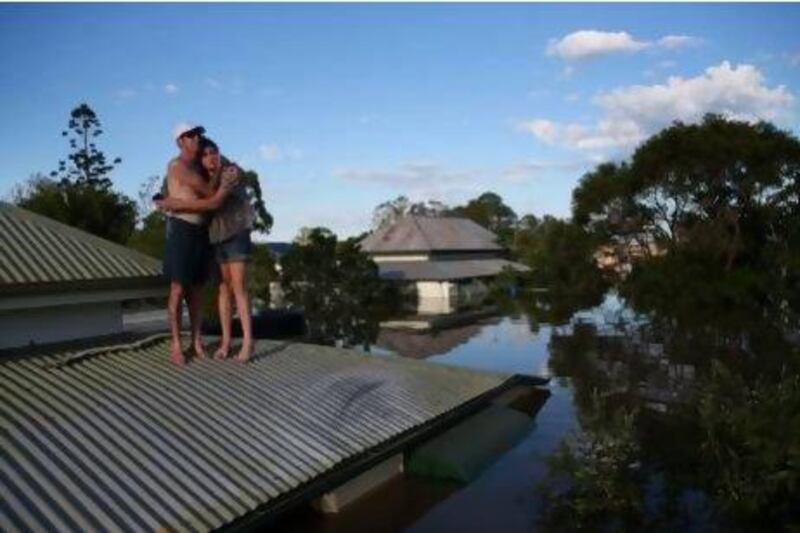SYDNEY // From bushfires raging in searing tinder-dry conditions to surging floodwaters and destructive tornadoes, Australia has witnessed staggering climate extremes during its summer of 2013.
Already this month the country's largest city Sydney has endured its hottest day on record, a 45.8 degree Celsius scorcher during a heatwave so extreme heat scales on government forecast maps had to be redrawn.
Just a week later, ex-tropical Cyclone Oswald dumped torrential rain on coastal areas of Queensland, leaving four people dead, swamping 2,000 homes and forcing dramatic rooftop rescues of those trapped by the deluge.
The government deployed four military helicopters, 100 troops and three transport aircraft yesterday in its response to the crisis.
Some of the most wrenching footage from the floods in Queensland showed a toddler being winched to safety in a bag from the back of a truck. Robin Collie, 22, who is four months pregnant, said yesterday she felt "sick" as her sobbing 14-month-old son Luke was lifted from her arms by a helicopter rescue team. She had been driving to the town of Biloela in northeastern Queensland when her utility truck hit a submerged tree and stalled in rising floodwaters. Luke was too small to fit into the rescue harness and had to be zipped into a waterproof equipment bag. "The worst part was seeing him go up in the bag," she told Seven News. "(I felt) sick, it's your baby, it's your life. Putting him in a bag and zipping it up, God, above water that could carry him away."
Julia Gillard, the prime minister, who on Monday toured bushfire-hit areas in southeastern Victoria state even as turbid floodwaters swamped the nation's north-east, said the contrast was not lost on her.
"I was looking at blackened landscape, burnt trees, black earth; saw some homes that were just completely destroyed," she told ABC Radio.
"They were the images in my eyes directly yesterday, and then whenever I saw an image coming from Queensland, it's of wild weather and cascading water ... flooded homes ..."
"Doesn't that say something about Australia? If you had the ability to take some water from one part and just put it on another part and put those fires out in Victoria, then you would. But life's not like that."
Climate change expert David Karoly, an adviser to the government's Climate Commission, said while there have always been floods and fire in Australia, recent events were consistent with global warming and could become more frequent with climate change.
"On average, over a number of years, we would expect more heavy rainfall and more hot extremes and more extreme bushfire weather conditions," he said.
"So Australia is a land of drought and flooding rains, yes. More droughts and worse flooding rains."
Australia experienced an extended period of exceptionally widespread hot weather in January, resulting in the nation experiencing its hottest day on record on January 7 with the average maximum temperature hitting 40.3 degrees.
"It was a very extreme event, a very unusual event," said Markus Donat, a climate researcher at the University of New South Wales, adding that the dices were loaded for more of the same due to global warming.
"Of course in a warmer world you will have more days exceeding the threshold for unusual temperatures," he said. "The probability of a warm extreme event becomes higher."
The hot weather exacerbated bushfires in Tasmania, New South Wales and Victoria, destroying more than 100 homes, and saw the weather bureau introduce new colours to its weather scale to cover projections for new high forecasts.
Separately, tropical Cyclone Oswald touched down on the Queensland coast, and after it was downgraded the storm brought high winds, torrential rains and even, to the east coast town of Bundaberg north of Brisbane, tornadoes.
Australia has weathered unprecedented natural disasters in recent years, with 173 people perishing in the 2009 bushfires in Victoria and floods in Queensland in 2011 claiming 35 lives and causing millions of dollars in damage.
With some areas flooding in Queensland just two years after they went under water in the 2011 disaster, the question of climate change and urban planning has arisen.
Barbara Norman from the University of Canberra said a focus should be coastal areas, where some 85 per cent of Australia's 23 million population live and which are vulnerable to weather extremes such as cyclones and tidal surges.
"It is time to respect our coastal environments and better plan for extreme weather to protect our coastal communities and habitat," she said.
"We are living with environmental change and we simply cannot afford to continue to develop in areas that are at very significant risk."





